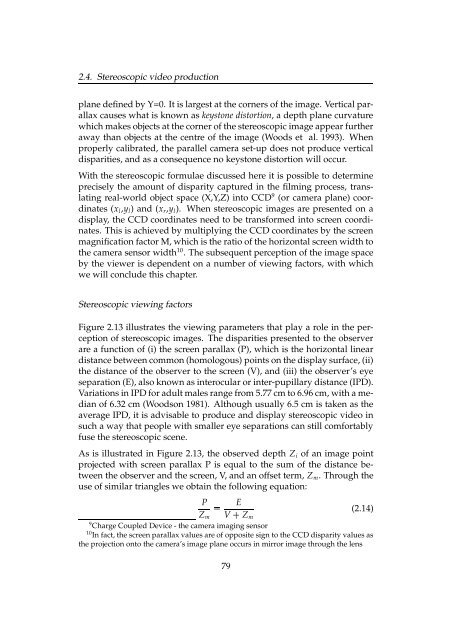Chapter 2 Principles of Stereoscopic Depth Perception and ...
Chapter 2 Principles of Stereoscopic Depth Perception and ...
Chapter 2 Principles of Stereoscopic Depth Perception and ...
Create successful ePaper yourself
Turn your PDF publications into a flip-book with our unique Google optimized e-Paper software.
2.4. <strong>Stereoscopic</strong> video production<br />
plane defined by Y=0. It is largest at the corners <strong>of</strong> the image. Vertical parallax<br />
causes what is known as keystone distortion, a depth plane curvature<br />
which makes objects at the corner <strong>of</strong> the stereoscopic image appear further<br />
away than objects at the centre <strong>of</strong> the image (Woods et al. 1993). When<br />
properly calibrated, the parallel camera set-up does not produce vertical<br />
disparities, <strong>and</strong> as a consequence no keystone distortion will occur.<br />
With the stereoscopic formulae discussed here it is possible to determine<br />
precisely the amount <strong>of</strong> disparity captured in the filming process, translating<br />
real-world object space (X,Y,Z) into CCD 9 (or camera plane) coordinates<br />
(x l ,y l ) <strong>and</strong> (x r ,y l ). When stereoscopic images are presented on a<br />
display, the CCD coordinates need to be transformed into screen coordinates.<br />
This is achieved by multiplying the CCD coordinates by the screen<br />
magnification factor M, which is the ratio <strong>of</strong> the horizontal screen width to<br />
the camera sensor width 10 . The subsequent perception <strong>of</strong> the image space<br />
by the viewer is dependent on a number <strong>of</strong> viewing factors, with which<br />
we will conclude this chapter.<br />
<strong>Stereoscopic</strong> viewing factors<br />
Figure 2.13 illustrates the viewing parameters that play a role in the perception<br />
<strong>of</strong> stereoscopic images. The disparities presented to the observer<br />
are a function <strong>of</strong> (i) the screen parallax (P), which is the horizontal linear<br />
distance between common (homologous) points on the display surface, (ii)<br />
the distance <strong>of</strong> the observer to the screen (V), <strong>and</strong> (iii) the observer’s eye<br />
separation (E), also known as interocular or inter-pupillary distance (IPD).<br />
Variations in IPD for adult males range from 5.77 cm to 6.96 cm, with a median<br />
<strong>of</strong> 6.32 cm (Woodson 1981). Although usually 6.5 cm is taken as the<br />
average IPD, it is advisable to produce <strong>and</strong> display stereoscopic video in<br />
such a way that people with smaller eye separations can still comfortably<br />
fuse the stereoscopic scene.<br />
As is illustrated in Figure 2.13, the observed depth Z i <strong>of</strong> an image point<br />
projected with screen parallax P is equal to the sum <strong>of</strong> the distance between<br />
the observer <strong>and</strong> the screen, V, <strong>and</strong> an <strong>of</strong>fset term, Z m . Through the<br />
use <strong>of</strong> similar triangles we obtain the following equation:<br />
P<br />
¢<br />
E<br />
(2.14)<br />
Z m V £ Z m 9 Charge Coupled Device - the camera imaging sensor<br />
10 In fact, the screen parallax values are <strong>of</strong> opposite sign to the CCD disparity values as<br />
the projection onto the camera’s image plane occurs in mirror image through the lens<br />
79


